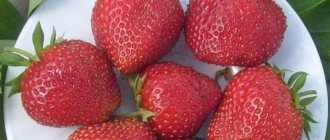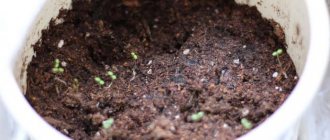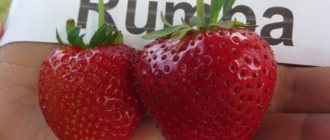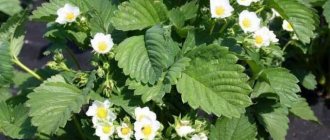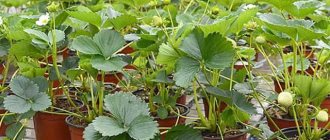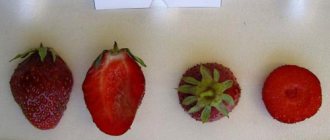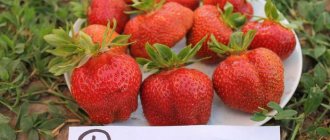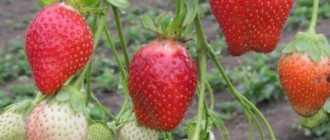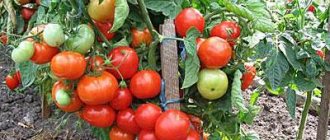Growing and care
Caring for Fireworks strawberries is easy. Successful cultivation is possible with timely rejuvenation of the plantation every 3-4 years.
Watering
The first waterings of Fireworks begin at the end of April. In hot weather, strawberry bushes need to be watered 2 times a week. During rainy periods, to avoid the development of gray rot, watering is stopped. But at the end of fruiting there is no need to stop irrigation; it is necessary to give the bushes the opportunity to develop full-fledged flower stalks for the next year. In autumn, strawberries are watered once every 10 days. The best time is early morning.
Loosening, weed control
Weeds take away nutrition and moisture from strawberries, so you need to remove them regularly. Loosening the soil is necessary in order to remove the dense crust that prevents the roots from breathing.
Mulching with agrospan will allow the gardener not to waste time on loosening and weeding. The material is not cheap, as is another mulching option - using organic mulch. Straw, sawdust, leaves, and remains of herbal infusion will serve as excellent mulching material. The only thing is that mulch needs to be used wisely. Remember - organic mulch, when it rots, binds nitrogen from the soil and only then releases it back into the ground. On poor soils, mulching must be accompanied by nitrogen fertilizing. In addition, strawberries are a plant that loves warmth; black soil warms up faster than the same soil, but through straw. Mulching can shift the start of fruiting to a later date.
Removing a mustache
The peculiarity of the variety is that it is necessary to regularly remove numerous whiskers from Fireworks. They grow quickly, thicken the bed and take away strength from the mother bushes. The mustache should be trimmed with pruning shears and not pulled out, so the likelihood of damage from the horn will be minimized.
Top dressing
Fertilizing begins in the second year after planting; in the first season of Fireworks strawberries, the fertilizer applied during planting is sufficient. Use organic fertilizers or ready-made mineral complexes. In early spring, nitrogen-containing mixtures are used, which will give increased growth of green mass, in September - phosphorus and potassium. Before flowering begins, watering is combined 2-3 times with the addition of a solution of mullein and wood ash.
Pest and disease control
Strawberries Fireworks are not susceptible to such dangerous diseases as powdery mildew and verticillium wilt, and are tolerant to spider mites. Under unfavorable weather conditions, there is a risk of white and brown leaf spots.
By observing crop rotation and a properly organized irrigation system, the likelihood of diseases and pests appearing on strawberries is significantly reduced.
Preparing for winter
Garden strawberries Fireworks have shown the ability to winter without shelter at temperatures down to -25℃. Covering with straw and spruce branches is carried out taking into account the climatic conditions of the region. Plants that are protected from the winds, which blow snow away from the plantings, are in a winning situation.
How to grow seedlings?
Seed material
Seeds used to grow plants need to be properly prepared. Soaking and stratification are required.
To carry out the soaking procedure, it is recommended to use ordinary paper napkins or cosmetic cotton pads. Water is taken raw and settled. For effectiveness, various growth stimulants are added to it. The seeds are laid out on top of the raw material.
When stratifying, the seed is covered with a second disk or newspaper and placed in the refrigerator for several days (3-4 days). Sowing can be done at any time of the year. If you want to get seedlings by spring, start work between January and February.
Soil and container
To germinate seeds, gardeners use various containers:
- peat cups;
- wooden boxes;
- plastic cups and containers.
You can use other suitable containers that you happen to have on hand.
Containers that were previously used are poured with boiling water with the addition of boric acid or potassium permanganate. New plastic containers must be washed with warm water and any detergent. Several holes must be made at the bottom of each container. It is better not to water small and young shrubs at the root, but to place them in a container in a tray with water to nourish the roots.
Strawberries love fertile and light soil. It is recommended to buy a complex mixture at a garden store or make it yourself.
When germinating, the seeds are not sprinkled with soil. The seed material is carefully laid out on the surface of the moist soil. After the seeds have been loaded, the container is covered with thick transparent film or glass.
The containers are placed in a warm room with a maximum temperature of up to 25 degrees Celsius. It is necessary to take care of a sufficient amount of light. If there is a deficiency, artificial sources are used. If the seeds have successfully passed stratification, the first shoots will appear in about 2-3 weeks.
As soon as you notice sprouts, open the cover above the container a little to let in fresh air, but it is still too early to remove it completely.
The minimum daylight hours should be 10-12 hours a day. It is better to use phytolamps as additional light sources. Optimal temperature conditions are about 20 degrees Celsius above zero.
Watering is carried out only if the top layer of soil is dry. Moisten the soil as carefully as possible using a spray bottle. Sprinkle the soil with a tiny dose of clean water. Excessive moisture can cause root diseases.
Features of watering
The procedure for watering seedlings of the “Fireworks” variety is carried out in different ways, it all depends on the stages of development of the bush.
- First, irrigate the soil with a spray bottle after sowing the grains.
- As soon as the seedlings have formed, watering is carried out once every 7 days.
- The frequency of watering increases to once every 3-4 days after the first true leaves appear on the seedlings. Make sure that the moisture reaches the bottom; to do this, place the container in the water.
Boiled water won't help. Melt or rain water is ideal, however, it can only be obtained during the rainy season.
Proper care
Caring for strawberries is not very difficult. The basis of care is:
- Timely cleaning of the area from weeds.
- Watering.
- Fertilizing the crop.
- Loosening the soil.
If you follow these rules, strawberries will definitely give a good harvest and will not get sick.
Watering
Water strawberries once a week. This is under standard conditions. If it is unbearably hot outside, then the number of waterings is increased to 2/3 depending on the temperature.
We also recommend reading: Description of the strawberry variety Elvira
You can water strawberries only with warm, settled water. You cannot use water from a well, as cold water can cause Fireworks to develop fungal diseases.
It is best to use a special drip irrigation system for irrigation. However, if it is not there, then you can water it manually, while observing some rules:
- Water when the sun is in its inactive phase: early morning or evening.
- Water strictly at the roots.
Water consumption per 1 m2 is approximately 10 liters.
Feeding
After planting seedlings, strawberries do not need to be fertilized. The nutrients that were added to the soil during its preliminary preparation are quite sufficient. Starting next year, strawberries are fertilized 3 times during the growing season:
- In early spring, nitrogen-containing fertilizers are applied. They stimulate the growth of the green part, thereby allowing the plant to quickly wake up from winter sleep.
- During the formation of ovaries, it is necessary to apply phosphorus-potassium fertilizers.
- And the last fertilizing is carried out after the entire harvest has been harvested. Fertilize garden strawberries with organic matter for the third time. It will provide the necessary supply of energy to the plant so that it can winter painlessly.
Loosening the soil
Despite the fact that loosening seems to be a useless procedure, in fact it plays a significant role for garden strawberries. Firstly, during loosening, insects that like to lie near the roots of plants are removed. The same larvae of May beetles. Secondly, loosening removes weeds. Thirdly, the soil becomes softer, which allows the crop to develop without problems. And finally, fourthly, the root system gets free access to oxygen, which is blocked due to the formation of a crust after frequent watering.
https://youtube.com/watch?v=LBMkFxEK4NE
Rules for planting garden strawberries
The volume of the harvest and the immunity of the plant depend not only on how high-quality the care is, but also on whether the site for garden strawberries was chosen correctly and whether it was planted correctly.
Garden strawberries can be planted both in autumn and spring. In spring, it is preferable to plant seedlings in colder regions so that the bushes have time to get stronger before the onset of cold weather. Autumn planting is carried out in warmer regions. It is also worth noting that when planting seedlings in the spring, it will be possible to get a harvest only after a season, that is, in a little more than a year. If planted in autumn, strawberries can be harvested next summer.
Even before planting begins, you need to select a suitable site. It should be sunny, without neighboring trees and tall bush crops (the variety does not grow in the shade). Groundwater should not lie close to the surface.
Once the site has been selected, it is prepared. This is done approximately 30-40 days before the planned work. Preparatory procedures include:
- Clearing the area of weeds. Weeds oppress the plant, taking nutrients from the soil.
- Its loosening. The soil is dug up or plowed to a depth of 30 cm.
- Soil fertilizers. The earth needs to be fertilized with organic matter. Approximately 8 kg of humus is used per 1 m2.
When the site is ready, you can begin planting seedlings. They are planted according to the standard scheme:
- Planting holes are dug out. The distance between the holes is 30 cm. The row spacing is about 60-70 cm. This will allow you to care for garden strawberries and harvest without any problems in the future.
- Then they are watered generously with water. When the water is completely absorbed, you can begin planting.
- Some gardeners recommend forming a mound in the center of the hole to make it easier to straighten the roots of the plant.
- The plant must be placed in a hole in an upright position. Horizontal positioning of the seedling is strictly prohibited.
- When the seedling is in the hole, it is sprinkled with soil. The soil is compacted.
- Upon completion of the work, the bushes need to be watered. Each plant is watered with approximately 1000 ml of water.
Features of the plant and fruiting
The variety belongs to the mid-season category: berry ripening begins in mid-late June and lasts until the first ten days of July (in the middle zone). Fruiting is short (1-2 weeks), but intense and friendly.
On bushes intended for fruiting, it is necessary to trim the tendrils regularly to reduce the load on the plant
The bushes are powerful, spherical, erect, with medium foliage. The leaves are dark green, glossy, flat. The flowers are large, white, untwisted. The whisker formation is active, the whiskers are of medium length, green. Peduncles are thick, short: located below the level of leaves; are formed on plants in large quantities (from 15 pieces), due to which more than 50 berries are set and ripened on each bush. The stalks are thick, brittle with large, complex calyxes.
Consumer qualities of berries
The fruits are quite large: in the main collection with an average weight of 13 g, the first ones can gain up to 30-35 g. Their shape is regular - truncated-conical, symmetrical, with a short neck. Ripe berries acquire a rich dark red color and glossy shine.
Berries are used universally: both fresh and for all processing methods.
The pulp is dense, dark red, with a sweet and sour taste and a characteristic strawberry aroma. The taste qualities were rated by professional tasters as dessert - 4.5-4.8 points (out of 5), sugar-acid coefficient - 7.77. According to the originator, the berries contain:
| Nutrients and beneficial substances | Quantity |
| Sahara | 7,3-8% |
| Acids | 1,03-1,2% |
| Vitamin C | 77 mg% |
Based on the results of studies conducted in 2006-2009. on the irrigated plot of the selection department of the Samara Research Institute of Horticulture and Medicinal Plants “Zhiguli Gardens”, the variety was recognized as very promising in terms of yield. Over the course of 3 years of fruiting, Fireworks had a high level of all components of productivity (a large number of peduncles and fruits on the bush, large berries), so experts recommend it for industrial plantings. The average yield is more than 500 g per plant or 155-184 c/ha, the transportability of the berries is good.
Sustainability
In reviews of the Fireworks strawberry, gardeners note among its important advantages its frost resistance and drought resistance, confirmed by expert opinions. According to VSTISP specialists, during field trials from 2002 to 2006 at the collection site of the Kokinsky strong point in the Bryansk region, the variety proved to be medium-winter-hardy.
Many nurseries and agricultural firms are engaged in the production and sale of planting material.
The variety’s resistance to major crop diseases and pests deserves special attention. “Fireworks” is practically not affected by:
- powdery mildew;
- verticillium wilt;
- late blight;
- gray fruit rot (yield loss 0-2%);
- spider mites (0 points – tolerant).
The only drawback of the variety is its high degree of damage to white and brown leaf spots (3-4 points out of 4) under stressful conditions (sharp hydrothermal changes) during the growing season.
Reviews
Svetlana, 56 years old, Belgorod region
I have been growing strawberries for sale for many years. I have different varieties; among the average ones, I consider Fireworks to be the most worthy - one of the best examples of Russian selection. The berries fill to a beautiful dark burgundy, almost cherry color, and shine. Some buyers even doubt them and consider them to be stale or rotten. In fact, ripe berries are incredibly tasty. The flesh is also dark, evenly dense, and oozes juice when you bite into it. But there is one important point: the rich taste appears only when fully ripe. Our variety winters safely without shelter, practically does not suffer from anything, and is unpretentious in care. Of course, you have to constantly remove mustaches from fruiting bushes, because they grow quickly and in large numbers. Otherwise, it all comes down to regular watering, fertilizing with organic matter 2-3 times per season and mulching the soil.
Oleg, 43 years old, Novoangarsk
We planted several Fireworks strawberry bushes at the dacha. The variety, as it turned out, is excellent: the productivity is high, even in the third year it did not decrease and the berries did not shrink in size. The bushes are tall, powerful, and during the fruiting period they are simply bursting with berries. They ripen very quickly and need to be collected every 2-3 days. On average, the yield per bush is 600-700 g. The only pity is that it ends quickly.
Valentina, 60 years old, Obninsk
In the conditions of the middle zone, not every variety of strawberry can produce a good harvest and tasty berries. Now I’ve settled on Fireworks: it has sufficient winter hardiness and is immune to most diseases and pests. It is better to conduct it in a 3-year culture. The berries are good fresh - juicy, aromatic, sweet with harmonious sourness. The pulp is homogeneous and quite dense, so it does not wrinkle during transportation and does not spread during heat treatment. I make classic strawberry jam from them to the delight of the whole family.
Strawberry variety Fireworks
The strawberry variety Fireworks is one of the domestic varieties with a medium ripening period and a universal harvest purpose.
The bushes are quite powerful, upright, spherical in shape, with average foliage. Mustaches of medium length, green in color. The originator of this variety, worthy in all respects, is the All-Russian Research Institute of Genetics and Selection of Fruit Plants named after I.V. Michurin. The “Fireworks” variety was included in the State Register of the Russian Federation quite a long time ago and has become most widespread in home gardening in the Central Black Earth region of our country.
Plant characteristics
The leaves are dark green, flat in shape, with a characteristic shine. The flowers are large in size, white, without petal torsion. Peduncles are medium in size, located below the level of the leaves. Productivity is high and constant. Fruiting is very stable.
Description of the berry variety
Fully ripened and ready for picking, the berries have an average weight of 11-13 g, regular shape and a short neck. The surface of the ripe berry is dark red in color, with a pronounced gloss. The berry is recommended for fresh use and is perfect for making jams and preserves.
The pulp of the ripe berry is dark red in color, dense in consistency, and sour-sweet in taste. The average sugar content is just over 7%. The acidity of the pulp does not exceed 1.2%. The amount of vitamin C is 77 mg/%. According to the tasting results, the berries scored 4.8 points. Average yields do not exceed 160−161 c/ha. The variety is characterized by resistance to fungal diseases and has relatively high winter hardiness.
Also read: Features of pruning grapes in spring
Planting and growing
It is recommended to plant Fireworks strawberries in August-September or early spring, preferably in cloudy weather. The ridges must be located in areas that are well protected from gusty winds. It is advisable that in winter the ridges be covered with a layer of snow by 25–30 cm. Only the largest and most healthy rosettes with a well-developed root system should be planted.
The area should not have any shadows
You should pay attention to the soil moisture indicators on the ridges allocated for growing this berry crop. Garden strawberries of the “Fireworks” variety can be grown from strawberry tendrils or by dividing the rhizomes of this berry crop
Almost any type of fertile soil, except peat soils, is well suited for planting strawberry seedlings. In order to obtain the best possible results, it is recommended to add humus and wood ash during deep digging of the soil.
For planting Fireworks strawberries, it is advisable to arrange ridges, the optimal width of which is no more than one meter, and the height can vary depending on the characteristics of the soil and the level of groundwater in the area. The length of the strawberry bed depends entirely on the gardener’s preferences, but should not negatively affect plant growth or complicate the care of the berry crop.
To get a high yield of high-quality berries when growing garden crops in open ground, it is necessary to carry out regular watering and prevent both the soil from drying out and being too waterlogged. Strawberries are fertilized at least three times per season and are always accompanied by abundant irrigation measures. Caring for berry plantations includes weeding, loosening and timely and correct preventive spraying of strawberry bushes.
Also read: Remontant beardless strawberries in the garden plot
Watering and fertilizing strawberries (video)
Berry plantings almost never get sick and winter very well in many regions without the use of shelter. The berry bushes are quite large, but not gigantic in size, and form mustaches, which greatly facilitates the independent propagation of the berry crop without the cost of purchasing planting material. High consumer ratings and positive reviews from gardeners allow us to recommend “Firework” as a promising variety for growing in garden plots and household plots.
Attention, TODAY only!
Did you find an error in the text? Please select it and press Ctrl+Enter. Thank you!
Rating:
Strawberry variety Fireworks. Description of the variety
The Fireworks variety has been registered in the State Register since 2000 and is recommended for planting in four agronomic zones: Central Black Earth, Volga-Vyatka, North Caucasus, East Siberian. Long-term tests have shown that the Firework strawberry is successfully developing in other Russian regions: in the North-West, in the Urals, in Western Siberia.
The ripening period is characterized as average; the yield of the harvest is extended.
Berries of the Firework variety
Strawberry Fireworks immediately attracts attention with the rare color of the berries: they are dark burgundy, glossy, and very appetizing. The pulp is beet red, without voids, dense, does not flow
The fruits do not get wet during collection and transportation. They can be stored in the refrigerator for three days without loss of quality; do not deform when frozen.
The shape of the berries is smooth, symmetrical, elongated-conical, slightly flattened on the sides. The neck is of medium size. The weight at the first harvest reaches 30 - 40 g, the average for all harvests is 13 - 16 g. From 10 sq. m receive at least 16 kg of vitamin products.
Problematic moment
There are two disadvantages of this variety:
- The sweet, rich taste appears only at full ripeness.
- The tip of the berry remains green for a long time.
It is recommended to collect only fully colored fruits. Fortunately, they are not prone to limpness even when overripe. Ripened Fireworks strawberries are rated 4.6 – 4.8 points during tasting.
Bushes
The foliage is erect, not too dense, of medium height. The petioles are green. The plants are quite compact, spreading up to 25 cm in diameter. Whiskers are formed in moderate quantities. The flowers are bisexual, and the self-fertility of the Firework variety is high. Thick fruit clusters do not rise above the bushes; they lie on the ground when the ovaries are filled
Care should be taken when harvesting, as fragile peduncles are prone to breaking.
Endurance
The Firework variety tolerates winter cold and summer heat equally well and does not make high demands on soil fertility.
Plants are resistant to harmful factors such as:
- transparent strawberry mite;
- white and brown spots on leaf blades;
- powdery mildew;
- verticillium wilt;
- late blight
Fireworks seedlings stand out for their healthy, medium-sized foliage.
The resistance of the variety to botrytis (gray rot of fruits) is at an average level. The disease causes significant harm in wet weather in dense plantings.
Features of agricultural technology
Strawberries Fireworks are grown using traditional technology of non-repairing varieties for open ground.
Subtleties of planting and care:
- The bushes are placed in a row at a distance of 30 cm from each other.
- It is recommended to use mulching materials to minimize damage from gray rot of berries.
- It is necessary to carry out preventive measures against botrytis: regular weeding; mowing tops after fruiting; spraying:
- fungicides (Propi Plus, Agrolekar, Forecast);
- biological products (Alirin, Gamair, Fitosporin);
- folk remedies (solutions of iodine and potassium permanganate, infusions of mustard and garlic).
The productive life of a plantation for Fireworks strawberries is determined to be 3–4 years, after which the mustaches are planted in new beds.
Description of garden strawberry variety Fireworks
Strawberry Fireworks was born in the city of Michurinsk, at the Federal Scientific Center named after I.V. Michurin. Its “parents” are the well-known strawberry varieties Zenga Zengana and Redcoat. In 2000, the variety received a “registration” in the State Register and is recommended for the Volga-Vyatka, Central Black Earth, North Caucasus and East Siberian regions. The climate of these areas varies significantly, which indicates the high adaptability of the variety to external conditions. This is evidenced by the successful experience of growing this strawberry in the middle zone and in the Volga region.
Fireworks is a mid-season variety: the first berries begin to be picked at the end of June. The variety is distinguished by its uniform ripening of the crop: the entire fruiting period usually fits into two weeks.
The bush is large, erect, almost spherical in shape, the foliage is medium. The root system is powerful. The mustache is green, medium in size, and has a moderate number. The leaves are dark green, flat, and have a significant shine. The flowers are white, large. Peduncles of medium size. The stalks are thick. Peduncles mainly hold the berries; their lodging on the ground is small.
It is important that the berries ripen almost simultaneously
The berries are medium-sized, weighing about 13 g (the first ones weigh up to 35 g). Their shape is regular, close to conical with a blunt apex, the color is dark red with a shine, and can even be cherry. The pulp is dense, also dark red, fleshy, with a lot of juice, excellent sweet and sour taste. The rating given by the tasters was 4.8 points.
The yield is quite high: when tested in field conditions, an average of 160 centners were harvested per hectare. In amateur gardens, with careful care, up to 1 kg of berries are collected from one plant. The variety is highly resistant to fungal diseases and is relatively winter-hardy. In seasons characterized by “temperature swings”, leaf spot disease is possible.
Origin and registration
“Firework” is one of the many descendants of the legendary “Zenga Zengana”, obtained as a result of its crossing with “Redcoat” at the All-Russian Research Institute of Genetics and Selection of Fruit Plants named after. I. V. Michurina. Since 1990, the variety has passed state tests and been tested by specialists from VSTISP and other research organizations. Officially registered in the State Register of the Russian Federation in 2000 as approved for cultivation in open ground in the Volga-Vyatka, Central Black Earth, North Caucasus and East Siberian regions.
The berries of this variety are distinguished by their rich dark red color and bright shine.
In practice, the variety has demonstrated excellent results in other regions, in particular the Central and Middle Volga.
Description of the strawberry variety Fireworks
The strawberry bush is powerful, erect, and resembles a ball in shape. The leaves are flat, slightly shiny, dark green in color, medium in size.
The root system is strong, fibrous, branched. Adult plants have a main rhizome and adventitious lateral fibrous roots.
Strawberries of the Firework variety bloom profusely. Not very tall, but quite powerful peduncles are located below the leaves. Despite the large number of inflorescences and berries, they are held in weight. The flowers are white, large, belong to both sexes, for this reason the berry set is high.
The number of whiskers formed is average.
The berries are medium in size - about 13 g. Their shape is round or conical, with a blunt end. The color is bright red, in the stage of full ripeness it is dark red, reaching cherry. The berry pulp of this variety is juicy, dense, fleshy, with a strong aroma, and when cut it is red without inclusions. The taste is rich, sweet and sour. Strawberries contain 7.4% sugar and 1.3% acid. According to the tasters, the Firework variety received 4.8 out of 5 points for taste.
Reproduction
The “Fireworks” variety can be propagated using a mustache or dividing bushes. You can grow seedlings using seeds. This method is very labor-intensive and complex, however, in this way you can get healthy seedlings, the quality characteristics of which will not be in doubt.
When purchasing seedlings on the market, you risk buying a low-quality product. Often purchased bushes do not correspond to the specified variety, and it is very difficult to visually determine the type of garden strawberries based on young bushes.
Characteristics of the variety
Among the main characteristics of the variety are:
- ripening time is average;
- fruiting is not remontant;
- productivity – high;
- purpose – universal;
- resistance to pests and diseases is average.
Main advantages
The description of the Firework strawberry variety, photos and reviews of gardeners about the plant allow us to conclude that it is advisable to grow the crop throughout almost the entire country with a guarantee of obtaining a high yield. Among the advantages and disadvantages are:
- drought resistance;
- winter hardiness;
- high immunity to diseases (gray rot and powdery mildew);
- versatility of berries;
- excellent transportability;
- the ability to grow a variety in one place without loss of yield.
Flowering period, ripening time, yield
Flowering and fruiting depend on the growing zone and climatic conditions. The further south the cultivation area is located, the earlier ripening occurs. Strawberries of the Firework variety are mid-season. Its flowering in central Russia begins in late May - early June, the berries ripen from late June to mid-July. Dates may change depending on the weather conditions of a particular year. Fruiting is one-time, friendly, strong: lasts no more than two weeks. The average yield of the Firework variety is consistently high and amounts to up to 1 kg per bush. The first berries are large - up to 35 g, in the main harvest - 15 g.
Application area
Strawberries of the Firework variety, which are at the stage of full ripeness and ready for picking, have a regular shape, a short neck, and a bright red glossy surface. The dense pulp with a sour-sweet taste contains a large amount of vitamin C. The berries are universal in use. They are used both fresh and for making jams, preserves, juices, compotes and wine. When freezing strawberries of this variety, all beneficial substances are completely preserved.
Resistance to diseases and pests
According to reviews from gardeners and breeders, strawberries of the Firework variety are resistant to major diseases and crop pests. It is practically not susceptible to gray rot and powdery mildew. The defeat rate in the worst years is only about 2%. The plant does not suffer from verticillium wilt and late blight. Spider mites are extremely rare on Fireworks strawberries. Most often, during the growing season, the plant is affected by white and brown leaf spots. This happens during temperature changes.
Advantages and disadvantages of the variety
Based on the description and photo of the Firework strawberry variety, a number of its advantages can be identified:
- resistance to major diseases;
- ease of care;
- undemanding to soil;
- extremely rare tick infestation;
- frost resistance with minimal shelter;
- adaptability to different climatic conditions of Russian regions;
- high yield when grown in one place for several years;
- excellent taste of berries;
- preservation of presentation for several days;
- good transportability;
- versatility of purpose.
Gardeners who grow the Firework variety do not note any particular disadvantages:
- The short period of fruiting can be regarded as both advantages and disadvantages of the variety.
- Gray rot and powdery mildew affect strawberries only with insufficient attention or extremely unfavorable weather conditions.
Reproduction methods
Strawberries of the Firework variety propagate in several ways:
- Usami is the simplest and most accessible propagation procedure, which consists of planting daughter rosettes from the mother plant. To do this, the most developed plants without defects are selected, which are then rooted in fertile soil to get a harvest the following year. The advantages of this method are the preservation of all the characteristics of the Firework variety and almost one hundred percent survival rate of planting material.
- Propagation by seeds is a long and labor-intensive process. It is necessary to prepare the seeds and soil and grow seedlings. Planting in the ground is carried out only if there are 5 - 6 true leaves.
- By dividing the bush, you can propagate Firework strawberries in the spring or immediately after harvest. To do this, you need to dig up a bush, soak it in water, and divide it into horns. After drying the planting material, you should clean it of yellow leaves, remove half the mustache, peduncles and leaves. After this, plant the horns in separate pots and place them in a greenhouse for 5 weeks. After rooting, they can be planted in a permanent place.
Landing in the ground
As soon as warm weather has established itself outside, without the risk of a return of night cold snaps and frosts, it is time to plant the seedlings in open ground.
It is recommended to harden off the plants before planting in the soil. Before transplanting into open ground, they are taken outside, gradually extending the time spent in the fresh air. This will help the plants adapt to new conditions. Do not leave boxes with seedlings in direct sunlight; it is better to place the container in the shade!
After the shrubs have been transplanted to the site, it is necessary to care for the plants and monitor their condition every day.
Main rules of care:
- Before planting, the soil is fed with complex fertilizers;
- water the bushes;
- remove weeds between strawberry seedlings;
- loosen the soil, saturating it with oxygen necessary for the development of the root system;
- carry out mulching, which helps maintain the required level of moisture, protects the roots and plant from insects and diseases, and also protects ripe berries from contact with the ground;
- remove tendrils from bushes, whose main task is to create a bountiful harvest.
The process of their formation takes a lot of effort from the plant. The mustache is left only on mother plants specifically intended for propagation of the crop on the plantation.
Advantages and disadvantages, features, differences from other varieties
A feature of the Fireworks variety is its relatively high yield with consistently excellent consumer characteristics of the berries: both taste and marketability. The high adaptability of the variety to climatic conditions allows it to be grown in almost any region, and the ability to be transported and the spectacular appearance of the berries provide grounds for growing the variety for the purpose of selling the crop in markets.
The main advantages of the Firework variety strawberries are:
- cold and drought resistance;
- high immunity to most diseases;
- good transportability of the crop;
- excellent berry taste;
- versatility of use;
- undemanding to growing conditions and qualified care;
- high yield over several years of bush life;
- friendly return of the harvest.
However, some gardeners do not consider the latter sign an advantage, preferring varieties with extended fruiting. Gardeners do not notice any other negative traits in the variety.
There are an order of magnitude fewer varieties of strawberries included in the State Register of the Russian Federation than, for example, varieties of cucumbers or tomatoes. Nevertheless, choosing the right one is becoming increasingly difficult: half a century ago they could be counted on one hand. What “helps” in choosing is that most of the available varieties are not recommended for all climatic regions. In this regard, among mid-season varieties, Fireworks has a significant advantage: many are approved for cultivation in only one or two regions. Perhaps the record holder for this indicator is the old Festivalnaya variety, bred in 1954. However, the taste of its berries is rated lower than the taste of the berries of the variety in question, and their size is slightly smaller.
The State Register has accepted the old variety Krasavitsa Zagorya, obtained in pre-war times, with almost no restrictions. The characteristics of this variety largely coincide with the characteristics of Festivalnaya. Among the varieties bred in recent years, the cold-resistant Geyser strawberry stands out for its excellent taste of berries, but it has a very low yield and is approved only in the Volga-Vyatka region. The completely new mid-season variety Pamyati Zubov, registered in 2021, deserves attention. Its highest resistance to heat, cold, and disease is declared, a higher yield than Firework is indicated, but the taste qualities are not described in the official document, and there are still practically no reviews about this variety.
Beauty of Zagorye is one of the few varieties that are approved for cultivation in a large number of regions
Thus, the Fireworks variety should be considered one of the best in its segment at the moment: almost all of its characteristics are positive.
History of selection
The strawberry variety Fireworks was obtained by crossing the well-known varieties Zenga Zengana and Redcoat. Selection work took place at the All-Russian Research Institute of Genetics and Selection of Fruit Plants named after. I. V. Michurina. The work was carried out in the nineties of the last century. At this time, the variety was tested and tested at VSTISP. Later, in 2000, Fireworks was officially registered in the State Register of the Russian Federation, according to which it was approved for cultivation in open ground in eastern Siberia, the Black Earth Region, in the Central and Volga-Vyatka regions, as well as in the North Caucasus. After practical application, strawberries of the Firework variety showed good results in the Central regions of the Russian Federation and the Volga region.
Features of care
In agricultural technology, Fireworks is no different from other strawberry varieties.
Watering and fertilizers
Although the variety is able to tolerate drought normally, it is highly undesirable to dry out the soil too much. Abundant watering should be carried out before fruiting begins. The soil must be constantly moist. When the fruits begin to turn red, irrigation procedures can be stopped.
Feeding is carried out three times per season. You can use both organic and mineral complexes. The first spring fertilizing is best done with nitrogen-containing mixtures, and the last, autumn fertilizing is best done with phosphorus-potassium mixtures. Before flowering begins, it is advisable to add humus, wood ash or manure.
Important! It is not advisable to feed strawberries in the first year after planting.
Soil care
Weeds are harmful to strawberries, as they grow intensively and quickly take away nutrients, so even the smallest ones need to be removed. It is necessary to loosen the soil to ensure access of oxygen to the roots. This should be done after each watering. You can use mulch to reduce loosening and remove less weeds.
